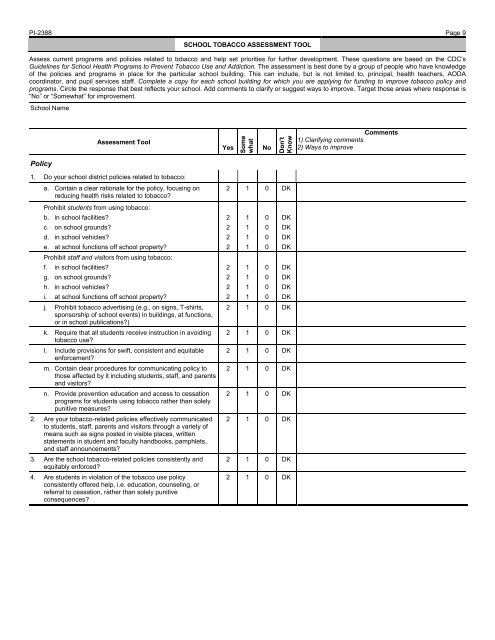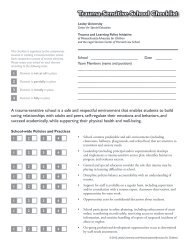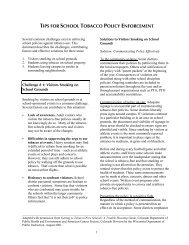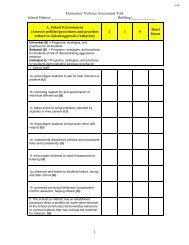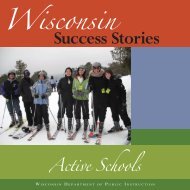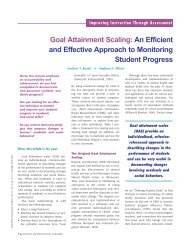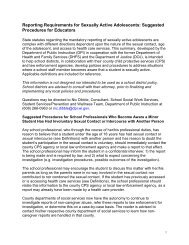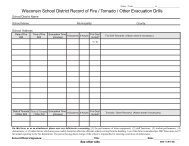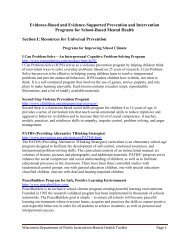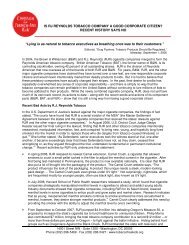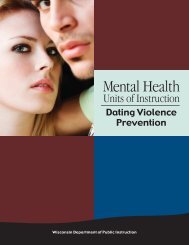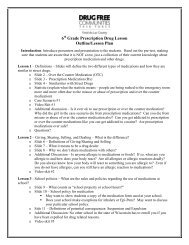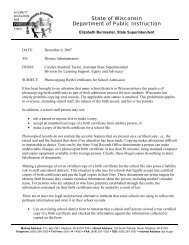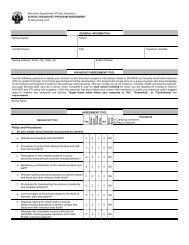Tobacco Prevention Program Assessment Tool - Student Services ...
Tobacco Prevention Program Assessment Tool - Student Services ...
Tobacco Prevention Program Assessment Tool - Student Services ...
You also want an ePaper? Increase the reach of your titles
YUMPU automatically turns print PDFs into web optimized ePapers that Google loves.
PI-2388 Page 9SCHOOL TOBACCO ASSESSMENT TOOLAssess current programs and policies related to tobacco and help set priorities for further development. These questions are based on the CDC’sGuidelines for School Health <strong>Program</strong>s to Prevent <strong>Tobacco</strong> Use and Addiction. The assessment is best done by a group of people who have knowledgeof the policies and programs in place for the particular school building. This can include, but is not limited to, principal, health teachers, AODAcoordinator, and pupil services staff. Complete a copy for each school building for which you are applying for funding to improve tobacco policy andprograms. Circle the response that best reflects your school. Add comments to clarify or suggest ways to improve. Target those areas where response is“No” or “Somewhat” for improvement.School Name<strong>Assessment</strong> <strong>Tool</strong>YesSomewhatNoDon'tKnowComments1) Clarifying comments2) Ways to improvePolicy1. Do your school district policies related to tobacco:a. Contain a clear rationale for the policy, focusing onreducing health risks related to tobacco?Prohibit students from using tobacco:b. in school facilities?c. on school grounds?d. in school vehicles?e. at school functions off school property?Prohibit staff and visitors from using tobacco:f. in school facilities?g. on school grounds?h. in school vehicles?i. at school functions off school property?j. Prohibit tobacco advertising (e.g., on signs, T-shirts,sponsorship of school events) in buildings, at functions,or in school publications?)k. Require that all students receive instruction in avoidingtobacco use?l. Include provisions for swift, consistent and equitableenforcement?m. Contain clear procedures for communicating policy tothose affected by it including students, staff, and parentsand visitors?n. Provide prevention education and access to cessationprograms for students using tobacco rather than solelypunitive measures?2. Are your tobacco-related policies effectively communicatedto students, staff, parents and visitors through a variety ofmeans such as signs posted in visible places, writtenstatements in student and faculty handbooks, pamphlets,and staff announcements?3. Are the school tobacco-related policies consistently andequitably enforced?4. Are students in violation of the tobacco use policyconsistently offered help, i.e. education, counseling, orreferral to cessation, rather than solely punitiveconsequences?2 1 0 DK2 1 0 DK2 1 0 DK2 1 0 DK2 1 0 DK2 1 0 DK2 1 0 DK2 1 0 DK2 1 0 DK2 1 0 DK2 1 0 DK2 1 0 DK2 1 0 DK2 1 0 DK2 1 0 DK2 1 0 DK2 1 0 DK
Page 10PI-2388SCHOOL TOBACCO ASSESSMENT TOOL<strong>Assessment</strong> <strong>Tool</strong>YesSomewhatNoDon'tKnowComments1) Clarifying comments2) Ways to improveCurriculum5. Which of the following are taught at your school in developmentally appropriate ways?a. Short and long-term physical consequences of tobaccouse.b. Short and long-term social consequences of tobaccouse.2 1 0 DK2 1 0 DKc. Accurate social norms regarding tobacco use. 2 1 0 DKd. Reasons students say they smoke. 2 1 0 DKe. Influences that promote tobacco use which includeadults, peers, and media.2 1 0 DKf. Skills for resisting social influences specific to tobacco. 2 1 0 DKg. General personal and social skills includingassertiveness, communication, goal-setting andproblem-solving skills.h. Advocacy skills applied to tobacco issues, such asrequesting smoke-free environments.i. Laws, rules and policies regulate the sale and use oftobacco.j. <strong>Tobacco</strong> manufacturers use various strategies toinfluence young people.k. Maintaining a tobacco-free environment has manyhealth benefits.l. Community organizations have information abouttobacco use and can help people stop using tobaccothrough cessation programs.m. Maintaining/developing commitment to not use tobacco,and confidence in ability to resist tobacco use.2 1 0 DK2 1 0 DK2 1 0 DK2 1 0 DK2 1 0 DK2 1 0 DK2 1 0 DKn. Skills to encourage others not to use tobacco. 2 1 0 DKo. Skills to communicate knowledge and personal attitudesabout tobacco use.2 1 0 DKp. Skills to identify and counter tobacco promotions. 2 1 0 DKq. Skills to cope with tobacco use by parents and otherfamily members.Instruction2 1 0 DK6. Are a wide variety of instructional methods includingdirect instruction, modeling, and rehearsal used to helpstudents develop tobacco-specific knowledge, attitudesand skills?7. Is tobacco instruction provided in every grade in theschool?8. Is the tobacco instruction integrated as part ofcomprehensive health instruction within the broaderschool health program?9. Are trained peer educators/leaders assisting with theclassroom instruction?10. Does your school regularly involve community agencystaff as guest speakers?11. Do student services personnel present consistenttobacco-free lifestyle messages through counseling andeducational materials?2 1 0 DK2 1 0 DK2 1 0 DK2 1 0 DK2 1 0 DK2 1 0 DK
PI-2388 Page 11SCHOOL TOBACCO ASSESSMENT TOOL<strong>Assessment</strong> <strong>Tool</strong>YesSomewhatNoDon'tKnowComments1) Clarifying comments2) Ways to improveTraining12. Does your school provide training or other staff development for all teachers and other school staff providing tobacco instruction which…a. Helps them understand the theory and model underlyingthe specific curriculum?b. Includes a review of the entire program or curriculum andrationale for including each part?2 1 0 DK2 1 0 DKc.Models and helps staff practice instructional activities? 2 1 0 DK13. Do all students who teach other students about a tobaccofreelifestyle participate in training specific to curriculum orprogram?Family and Community Involvement2 1 0 DK14. Were parent or families involved in developing schooltobacco programs, policies and procedures?15. Does your school curriculum promote discussions at homeby assigning homework and projects that involve families?16. Are families encouraged to reinforce anti-tobacco messagesat home?17. Were youth involved in developing school tobacco programsand policies?18. Does your school provide parent education on tobacco useprevention, community smoking cessation resources, andparent/child communication?19. Does a diverse school-community committee provide adviceand direction on school tobacco programs and policies?20. Do school personnel participate in a local tobacco-relatedcommunity coalition or partnership?2 1 0 DK2 1 0 DK2 1 0 DK2 1 0 DK2 1 0 DK2 1 0 DK2 1 0 DKCessationCessation services include any of the following: a group tobacco cessation program; brief clinical counseling from a nurse, counselor or other studentservices professional; self-help cessation materials; telephone quit lines or; referral to a physician.21. Does your school offer tobacco-use cessation services atschool for students?22. Does your school refer students to tobacco-use cessationservices in the broader community?23. Does your school offer tobacco-use cessation services atschool for school staff or refer to services in the broadercommunity?2 1 0 DK2 1 0 DK2 1 0 DKEvaluation24. Does your school regularly and systematically assess theeffectiveness of its tobacco-related policies?25. Does your school regularly and systematically assess theeffectiveness of its tobacco curriculum and instruction?26. Does your school regularly and systematically assess theeffectiveness of the tobacco use prevention staffdevelopment trainings?27. Does your school regularly and systematically assess theeffectiveness of its referrals for tobacco use cessationprograms for students?2 1 0 DK How?2 1 0 DK How?2 1 0 DK How?2 1 0 DK How?


